Rural Youth: Their Situation and Prospects - 1938
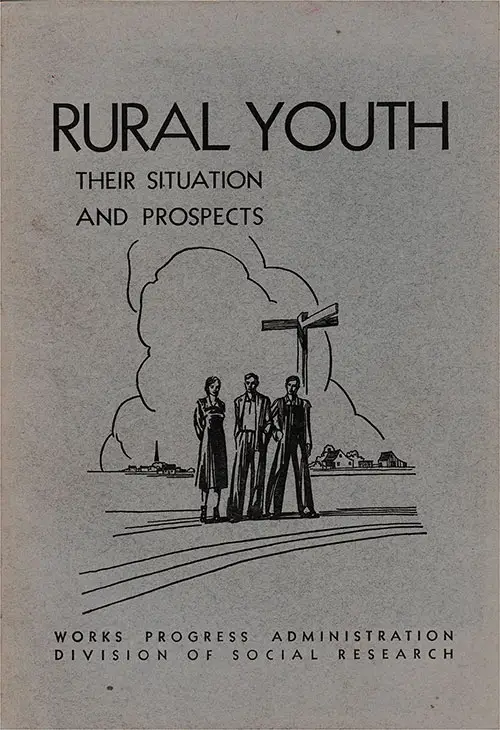
Front Cover, Rural Youth -- Their Situation and Prospects, Works Progress Administration, Division of Social Research, 1938. GGA Image ID # 1531986355
Letter of Transmittal
Works Progress Administration,
Washington, D. C,
July 15, 1938.
Sir: I have the honor to transmit an analysis of the present situation and future prospects of rural youth. The report is based on a comprehensive survey of the field studies and general literature dealing with rural youth.
Although there is already a "surplus" of rural youth, their numbers will increase steadily until sometime between 1940 and 1945. Even assuming a considerable urbanward migration of farm youth, it appears that there will be over 1,000,000 more youth in rural territory in 1940 than there were in 1930. With economic opportunities in rural areas already far from adequate to meet the demands of youth, the gravity of the situation is evident. Moreover, young people in rural areas are definitely handicapped with respect to educational and recreational facilities.
Many agencies, both governmental and nongovernmental, are providing services and opportunities for rural youth, but their largely uncoordinated efforts reach only part of the rural young people who need assistance. Fundamental amelioration of the situation calls for united efforts in behalf of equalizing opportunities.
This study was made in the Division of Social Research under the direction of Howard B. Myers, Director of the Division. The data on which the report is based were collected and analyzed under the supervision of T. J. Woofter, Jr., Coordinator of Rural Research.
The report was written by Bruce L. Melvin and Elna N. Smith. It was edited by Ellen Winston. Special acknowledgment is due the personnel of the National Youth Administration and of the Office of Emergency Conservation Work both for data and for constructive criticism.
Respectfully submitted.
Corrington Glll,
Assistant Administrator.
Hon. Harry L. Hopkins,
Works Progress Administrator.
INTRODUCTION
Youth is a period of economic and social adjustments. As the transition period from childhood to maturity it has tended progressively to expand as civilization has advanced.
It is here denned as including all young people 16 through 24 years of age. In a democracy it is society's obligation to make certain provisions for this transition period.
Schools have been made available on the secondary and college levels to prepare youth for making their adjustments, since it has been assumed that economic opportunity is open to the youth who are prepared through education to take advantage of it.
Despite the expansion of educational facilities, however, present economic opportunities are so limited that large numbers of young men and women are unable to establish themselves in a field that may be expected to lead to economic security. As a result the problems of youth have become serious and far-reaching in their implications and effects.
Lack of economic opportunity with the resultant social consequences of unemployment, underemployment, or employment at work, which is unsuited to individual temperament or capacity has, of course, not been limited to youth in recent years.
But the demoralizing psychological effects of idleness, discouragement, and frustration during periods of economic stress are particularly far-reaching and lasting for youth.
In recent years unemployment has been widespread among rural as well as urban youth, although more notice has been taken of the latter. Too often the rural youth situation has been dismissed with the statement that at least the young people on farms need not starve.
Such summary disposition of the matter fails to take account of the other necessities of human living or of the fact that there are thousands of rural young people in small towns who are just as desperate as their city cousins for a chance to develop their capacities and to banish the specter of insecurity.
Many individuals and organizations are interested in the welfare of rural youth. Numerous programs are being planned in an attempt to meet their problems.
To guide this planning there has been a distinct need for a comprehensive statement of the general situation faced by youth in rural areas as well as a digest of what is known about the condition of youth in specific areas.
Before new studies and programs are undertaken, it is important to know what information past surveys, other studies, and census data have yielded.
A great deal of miscellaneous material of varying quality is available, including some studies made on a State basis. The usable data on many topics are exceedingly scanty, however, and point to the need for further research.
An effort has been made in this report to summarize such data as are available and to supplement them with an evaluation of the situation and prospects of rural youth.
Chapter I discusses the distribution of youth; chapter II deals with their economic situation; chapter III treats of their educational status and opportunities; chapter IV takes up the marital condition of youth, while chapter V summarizes their recreational opportunities.
Chapter VI discusses what governmental agencies and some nongovernmental agencies with programs for rural youth are doing in attempting to meet the situation faced by youth.
The final chapter attempts to interpret the general situation and to point out the implications of the data presented in the preceding chapters for future programs and policies.
SUMMARY
During THE early thirties, when economic opportunity was at a minimum, more youth were maturing in the United States than ever before. In 1935 there were in this country approximately 20,800,000 youth, 16-24 years of age, almost 10,000,000 of whom were in rural areas—a record figure in each case. Moreover, it is estimated that by 1940 the total will have increased to more than 21,500,000 with well over 10,000,000 youth in rural areas.
DISTRIBUTION OF YOUTH
Youth is the principal age of migration just as it is the period of occupational and marital adjustment. In the past migration to the cities has tended to take care of the surplus population of rural areas.
The checking of this migration during the depression, as economic opportunities in urban areas were sharply curtailed, resulted in the "piling up" of youth in rural areas and the emergence of a major rural youth problem.
During the decade from 1920 to 1930 the net migration from farms totaled 6,300,000 persons of whom about 2,000,000 were youth 16-24 years of age. Girls left at an earlier age than boys, and more young people left the poor agricultural areas than the better farmlands.
Southern Negroes moved in large numbers from farms to the cities in their own section as well as to the cities of the North. At the same time there was a steady migration from cities to farm areas close at hand, causing the largest population increases for the period to occur in the territory close to industrial and commercial centers.
Of the rural youth reported by the 1930 Census, over 40 percent lived in nonfarm areas. In the largely nonagricultural New England, Middle Atlantic, and Pacific Divisions nonfarm youth constituted over one-half of the rural total.
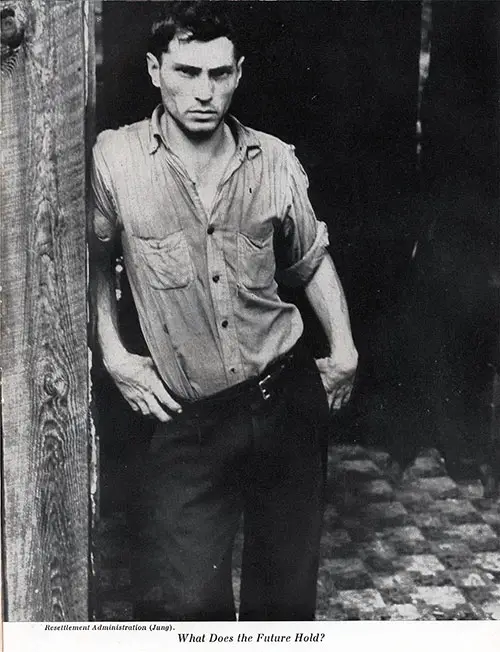
What Does the Future Hold for this Young Man. Photograph by the Resettlement Administration (Jung). Rural Youth -- Their Situation and Prospects, Works Progress Administration, Division of Social Research, 1938. GGA Image ID # 1532442bee
In the dominantly agricultural areas the problems of farm and nonfarm youth are similar, but in primarily industrial areas the problems of rural-nonfarm youth may have little relation to agriculture.
In the South race questions complicate the situation since Negro youth form an important proportion of the rural population, larger in the farm than in the nonfarm group.
Even at the beginning of the depression the pressure of farm youth on employment opportunities was more acute than that of rural- nonfarm youth. Pressure on the land as measured by replacement rates of rural-farm males was particularly heavy in the Southern States.
The excess of country youth was accentuated between 1930 and 1935 as rural-farm youth increased much more rapidly than rural-nonfarm youth. While all rural youth increased approximately 13 percent, farm youth increased almost 19 percent to a record total of 6,107,000.
The checking of the cityward flow after 1930 contributed greatly to the increase by 1935 of 1,150,000 in the number of rural youths, while the youth population in the cities was declining.
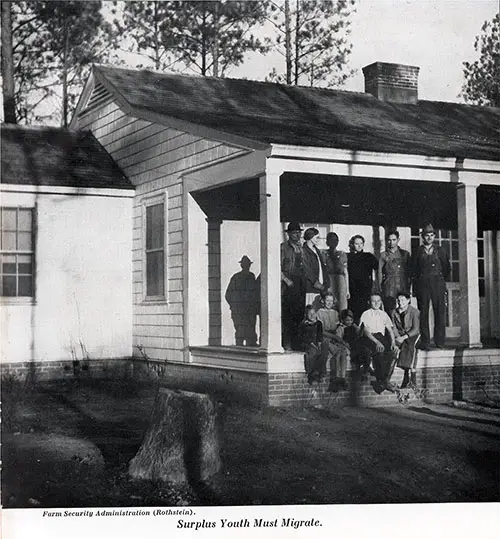
Surplus Rural Youths Must Migrate. Photograph by the Farm Security Administration (Rothstein). Rural Youth -- Their Situation and Prospects, Works Progress Administration, Division of Social Research, 1938. GGA Image ID # 1532a044af
The net migration varied from State to State. Apparently, more youth migrated to than from farms in the New England, Middle Atlantic, and East North Central States, reflecting the shutdown in industry in those regions.
In other regions youth left the farms in spite of the limitations of industrial and commercial opportunities. Where farm income has normally been very low and where drought and dust storms have been severe, youth have migrated in large numbers.
The extent of migration to cities within the next few years will have an important effect on the rural youth problem through its effect on the pressure on employment opportunities in rural areas.
Without such migration there would be almost 2,000,000 more rural youth in 1940 than in 1930. Even with the expected migration there will be between 500,000 and 600,000 more rural-farm youth and 500,000 more rural-nonfarm youth in 1940 than in 1930.
ECONOMIC SITUATION OF RURAL YOUTH
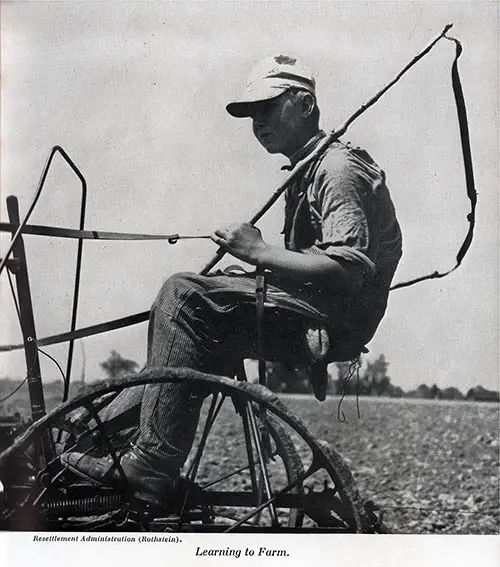
A Rural Youth Learning to Farm. Photograph by the Resettlement Administration (Rothstein). Rural Youth -- Their Situation and Prospects, Works Progress Administration, Division of Social Research, 1938. GGA Image ID # 15333d900d
In the past, economic security in rural society has been measured chiefly by property ownership. The farm youth expected to acquire a good farm free of debt and the village youth ultimately to own a business or to attain a secure position in some profession or skilled trade.
The large-scale development of lumbering, mining, and textile industries introduced a wage-earning class into this system, and there has been an increasing trend toward dependence on wages for part or all of the income. Meanwhile, youth have been "piling up" on the home farm where they receive little or no return other than subsistence for their labor.
With more and more youth accumulating on the home farms, and as the possibility of finding economic security through migration to urban areas decreases, their situation becomes of course less tolerable.
In poor land areas, like the Lake States Cut-Over, the trouble is acute on account of the extremely small return for their work and the large proportion of youth who have no work at all.
Even on good land the increased number of youth of employable age who cannot find a living away from the home farm is affecting the economic balance.
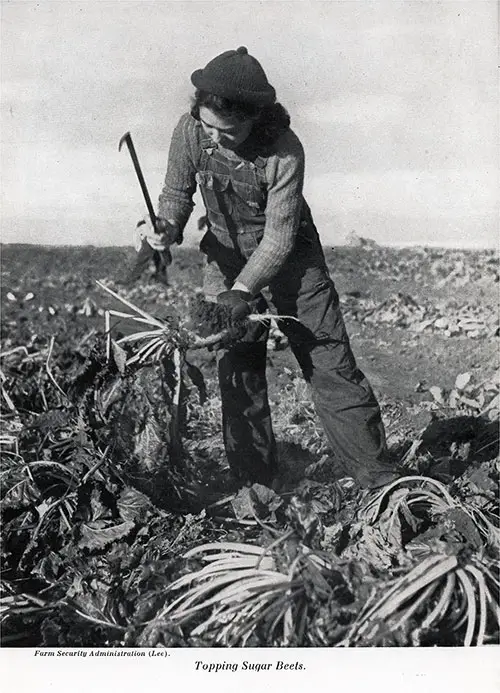
Young Female Youth Seen Topping Sugar Beets. Photograph by the Farm Security Administration (Lee). Rural Youth -- Their Situation and Prospects, Works Progress Administration, Division of Social Research, 1938. GGA Image ID # 15334c5c9d
The situation of young women forced to remain on the home farm is probably more precarious than that of the young men since little, but housework and farm labor are available to them.
In general, it appears that young women working at home are less likely to receive wages from parents than are young men, and in the poorer areas their role is regularly that of unpaid servants.
Probably not less than 2,000,000 rural youth have been members of relief households at some time since 1930. The peak in the number of households was reached in February 1935 when approximately 1,370,000 rural youth were receiving aid.
By October the number of youths on relief had declined to 625,000. Most of those removed from the relief rolls had been transferred to the Civilian Conservation Corps or with their families to the Resettlement Administration so that the decline in the number receiving some form of Government aid was probably not great.
Young men left the general relief rolls more rapidly than young women, and older youth found more opportunities for going off relief than did those under 20 years of age.
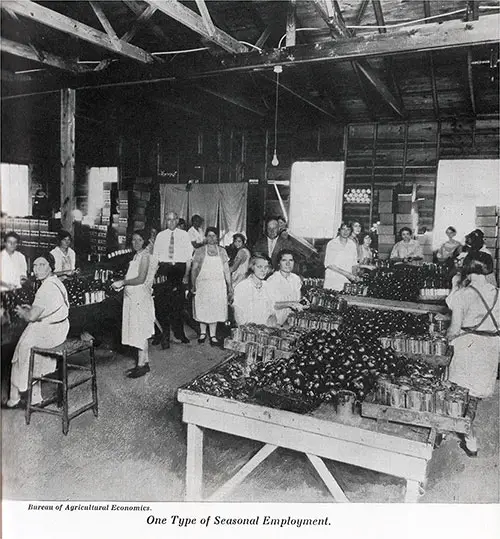
One Type of Seasonal Employment -- Workers at a Canning Facility. Photograph by the Bureau of Agricultural Economics. Rural Youth -- Their Situation and Prospects, Works Progress Administration, Division of Social Research, 1938. GGA Image ID # 153376bad3
Developments of recent years have greatly reduced the opportunities of rural youth for attaining economic security.
Progress toward farm ownership is hindered and frequently prevented by the growing burden of debt, the increase in tenancy, the decreased demand for farm laborers, the trend toward large-scale ownership of land, mechanization of agriculture, and the development of large areas of agricultural maladjustment.
The children of owner-operators therefore start as laborers, like their parents, but unlike their parents they often remain permanently in that or the tenant class.
The alternatives presented to underprivileged farm youth appear to be three—to remain in the country at a low level of living, to go to the cities to compete for jobs at very low wages, or, if their need is sufficiently great, to obtain jobs provided by one of the governmental agencies.
There is no longer new acreage to be opened up, and much hitherto cultivated land is no longer profitable.
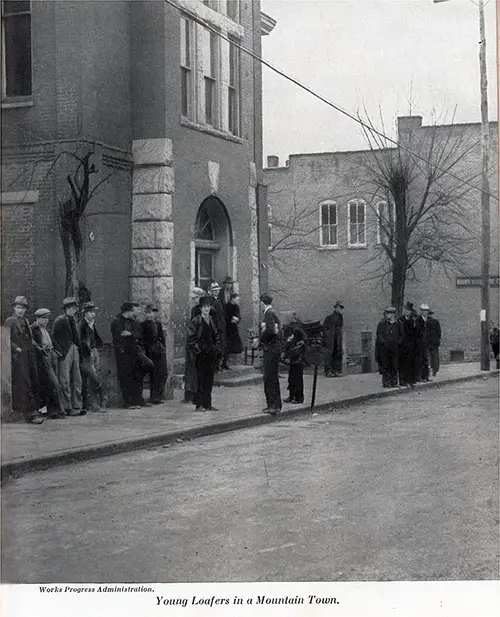
Young Loafers in a Mountain Town. Photograph by the Works Progress Administration. Rural Youth -- Their Situation and Prospects, Works Progress Administration, Division of Social Research, 1938. GGA Image ID # 1533c44c0d
Nonagricultural employment, instead of offering possibilities for the greatly increased number of maturing rural youth, has reduced its labor requirements, and the supply of local labor already trained is usually sufficient for its needs. Untrained rural youth going to industrial or urban areas ordinarily find opportunities only in the hardest and most menial work, which is also the most poorly paid.
EDUCATIONAL STATUS AND OPPORTUNITIES OF RURAL YOUTH
Rural youth are definitely handicapped in comparison with urban youth by the lack of educational facilities. Because of comparative lack of taxpaying ability rural States have the most meager provisions for public education. Hence the areas with the largest proportions of children have the poorest schools.
Largely because of the differences in educational facilities rural youth do not attend school to the same extent as do urban youth. Rural-farm youth attend school in smaller numbers proportionately and leave school earlier than do rural-nonfarm youth, also primarily because of variations in educational opportunity.
School attendance alone does not measure the educational situation, however, and many rural youths, particularly in the South, are greatly retarded with respect to grade attainment.
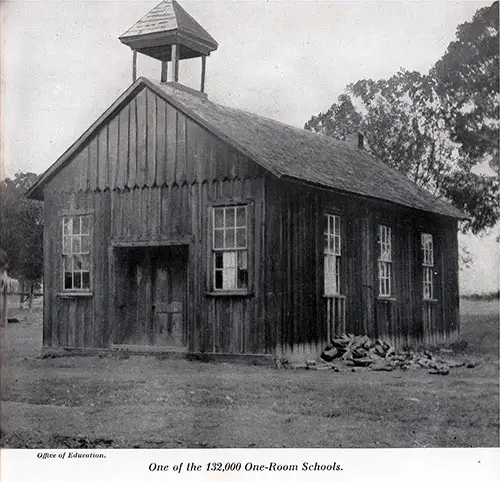
One of the 132,000 One-Room School Houses Across Rural America During the Depression. Photograph by the Office of Education. Rural Youth -- Their Situation and Prospects, Works Progress Administration, Division of Social Research, 1938. GGA Image ID # 1533d0a131
Moreover, although marked progress has been made, illiteracy is still prevalent in States with large reservoirs of surplus youth and with large numbers of Negro or Mexican youth. As late as 1930 about 1 out of every 20 rural-farm youth in the United States was still unable to read and write.
High school attendance increased during the period when employment was hard to find, the gain occurring in both town and country.
The National Youth Administration and other relief agencies have contributed to this development in recent years by assisting youth in the lowest income groups to continue in school. In rural areas where the educational handicap has been severe even in normal times, similar aid over a long period appears advisable.
Where facilities are available, a large proportion of all rural youth attend school, from which it may be assumed that with adequate opportunity a substantial increase in rural attendance can be expected.
Much Federal and local effort has been expended in extending rural high school facilities and especially vocational training in agricultural and homemaking courses.
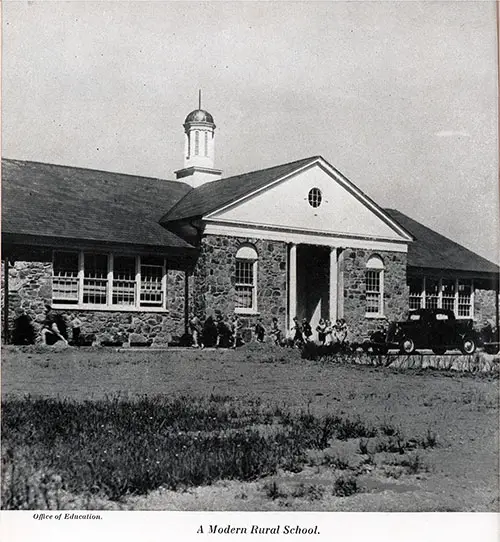
A Modern Rural School. Photograph by the Office of Education. Rural Youth -- Their Situation and Prospects, Works Progress Administration, Division of Social Research, 1938. GGA Image ID # 1533d49102
One of the most significant phases of the vocational agricultural work has been the development of the organization known as Future Farmers of America with its emphasis on practical farming experience.
The desirability of nonagricultural training for farm youth is made apparent by the shortage of farm work and by the usual unfitness of such youth to compete for urban employment.
MARRIAGE OF RURAL YOUTH
In farm life especially, marriage represents an economic as well as a social adjustment since the farm home and the farm business are one. It does not necessarily involve a comparable economic adjustment for rural-nonfarm youth since the young man may have become established in some occupation long before his marriage.
The proportion of youth married is greater for both sexes and for all years among rural than urban youth. At each year of age more young women than young men are married in both urban and rural territory. Early marriage of girls is particularly frequent in rural areas.
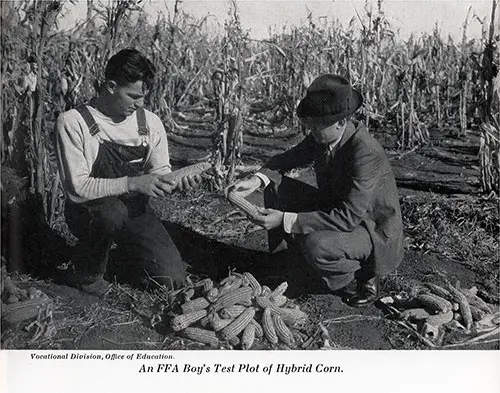
A Future Farmers of America Boy's Test Plot of Hybrid Corn. A FFA Advisor Discusses the Corn Crop with the Youth. Photograph by the Vocational Division, Office of Education. Rural Youth -- Their Situation and Prospects, Works Progress Administration, Division of Social Research, 1938. GGA Image ID # 1533dde515
More rural-nonfarm than rural-farm youth of both sexes were married in 1930. The higher rate among the rural-nonfarm group seems to be associated with large rural-industrial populations.
Moreover, most of the States with particularly high rural-nonfarm marriage rates are Southern States in which marriage rates among youth in general are high. Color also influences the proportion of youth who are married, relatively more Negro than white youth being married in all residence groups.
Between 1910 and 1920 there was an upward trend in the percent married among both rural and urban youth. In the twenties there was little change in the proportion of youth married, but during the early years of the depression (1929-1932) the marriage rate for the entire country fell, the decline appearing to be greater in urban than in rural areas.
As the rural depression had begun in the twenties, and the reduction in the marriage rate was then negligible, it seems doubtful whether depression conditions have any marked effect in causing farm youth to postpone marriage.
In 1933 the marriage rate began increasing and continued through 1934, returning practically to the 1929 level. This recovery was general among both rural and urban States.
USE OF LEISURE TIME
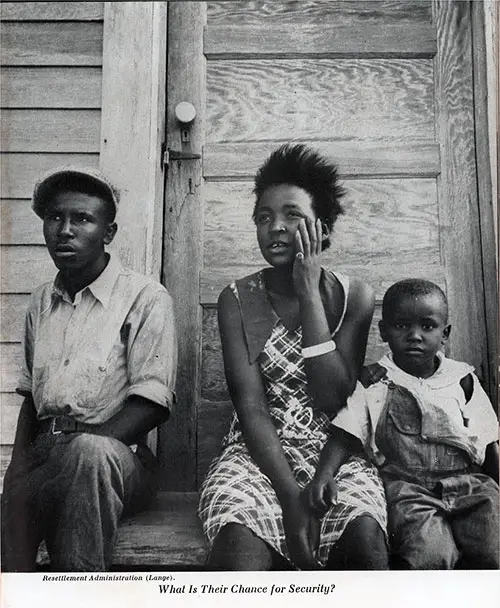
A Young, African-American Family During the Depression. What Is Their Chance for Security? Photograph by the Resettlement Administration (Lange). Rural Youth -- Their Situation and Prospects, Works Progress Administration, Division of Social Research, 1938. GGA Image ID # 15340f356d
The social adjustments of youth largely determine the patterns of their adult lives. Hence it is particularly important for a wide variety of wholesome recreational activities to be available for them.
Within recent years there have been many changes in the kinds of recreation in which rural youth indulge, as automobiles, motion pictures, and the radio have become generally available.
The rural community has frequently become disorganized and as a result has less and less control over the behavior of individual members.
So far rural communities have been slow to realize the social and recreational needs of youth and have made few attempts to meet them. On the other hand, a large proportion of rural youth do not participate in such institutions and organizations as have been developed.
Except for the church and Sunday school, organizations in rural areas have attracted a relatively small percentage of those eligible for member- ship and have often failed to meet the needs of those who did become members. The extent to which youth participate in social organizations apparently depends largely on their economic status and educational attainments.
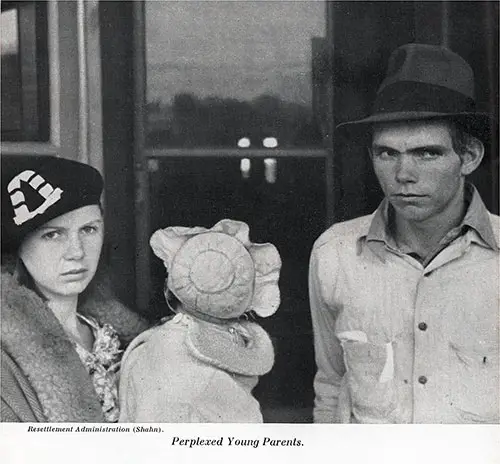
Perplexed Young Parents During the Depression. Photograph by the Resettlement Administration (Shahn). Rural Youth -- Their Situation and Prospects, Works Progress Administration, Division of Social Research, 1938. GGA Image ID # 153413dbc6
In addition to the church and other organizations there are many informal activities which absorb the leisure time of rural young people. The extent to which youth attend motion pictures and dances, belong to athletic groups, play games, read, etc., varies widely from one section to another.
The amount and type of reading is largely determined by the availability of library facilities. Recreation within the home is still of major importance and has received new stimulation and development as a result of the depression.
The lack of recreational activities is particularly acute in poor land areas. The various Federal emergency agencies established during the depression of the early thirties have made an important contribution through making available to rural areas some of the facilities for wholesome recreation, such as playgrounds, swimming pools, and community centers, which are taken for granted by city dwellers.
PROGRAMS TO AID RURAL YOUTH
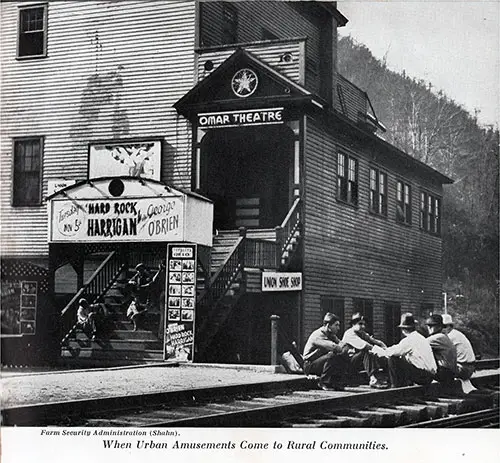
When Urban Amusements Come to Rural Communities. Signage Shows Marqee for "George O'Brien's Hard Rock Harrigan," "Union Shoe Shop," and "Omar Theatre." Youths are Shown Sitting on the Stairs and on the Side of the Building. Photograph by the Farm Security Administration (Shahn). Rural Youth -- Their Situation and Prospects, Works Progress Administration, Division of Social Research, 1938. GGA Image ID # 15344bbdcd
Many organizations, both governmental and nongovernmental, have developed definite and constructive programs for aiding rural youth.
The Cooperative Extension Service of the United States Department of Agriculture, operating through the State colleges of agriculture, promotes its work for youth through the 4-H Club program and through organizations for young adults.
The 4-H Club membership is composed primarily of young people below the youth group and includes chiefly young people in school from farm homes.
The program for older groups, which is still largely in the experimental stage, emphasizes the promotion of better farming and the development of leadership in educational and cultural guidance and in recreational activities.
The federally aided high schools with courses in vocational agriculture have expanded their part-time and evening classes in agricultural education since the depression of the early thirties.
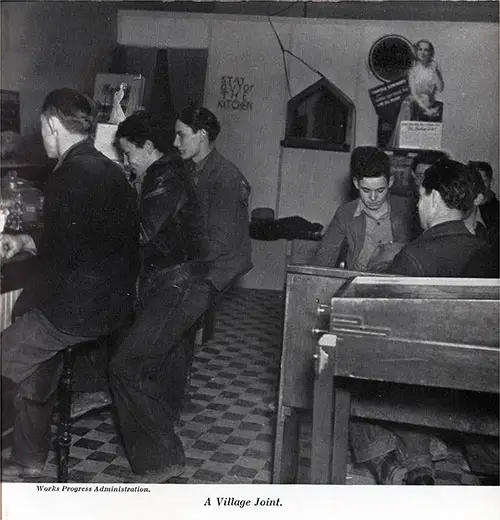
Youths Congregate at the Local Villiage Joint for Socializing, Food, and Refreshments. Photograph by the Works Progress Administration. Rural Youth -- Their Situation and Prospects, Works Progress Administration, Division of Social Research, 1938. GGA Image ID # 15345b12e8
Unemployed and out-of-school youth have been given training to equip them for work when the opportunity comes. The Office of Education has pioneered in many programs of value to rural areas, such as conservation, radio, and public forums.
The National Youth Administration has a varied program which covers a far more extensive group than the relief group for which it was organized primarily.
Its present services to youth include aid to those who cannot attend school without help, special courses at agricultural colleges for farm boys and girls, work projects for out-of-school youth, and vocational guidance and job placement. Through these various programs hundreds of thousands of youth are being aided.
The Civilian Conservation Corps has the threefold purpose of con- serving natural resources, providing employment for needy young men, and giving vocational training. By January 1, 1938, approximately 900,000 rural youth from low-income or relief families had spent one enrollment term or more in camp.
The Works Progress Administration, while it has no program especially designed for youth, has reached a considerable number of rural youths through its educational projects, work projects, and provision of recreational facilities.
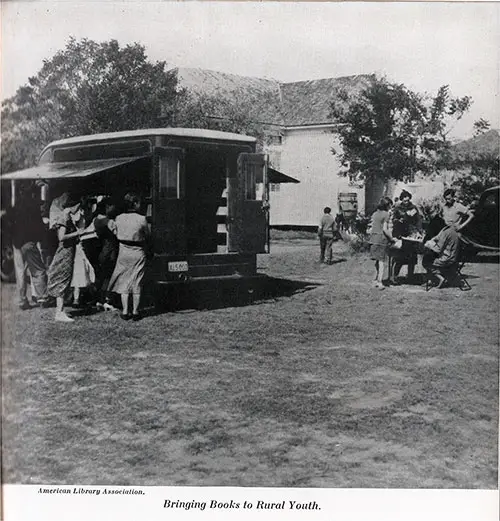
Bringing Books to Rural Youths During the Depression. Photograph by the American Library Association. Rural Youth -- Their Situation and Prospects, Works Progress Administration, Division of Social Research, 1938. GGA Image ID # 1534b8f74b
The Farm Credit Administration through its production credit associations to finance crop and livestock production and, more recently, through its program for giving youth opportunities to rent farms is helping young men get a start in farming.
The Agricultural Adjustment Administration and, more recently, the Soil Conservation and Domestic Allotment Act through assisting rural families have aided the youth in those families.
Similarly the Resettlement Administration, now the Farm Security Administration, has aided rural youth through helping their families. However, direct assistance to youth in making their own economic adjustments has not been rendered by these agencies.
The United States Employment Service helps young people as well as older workers to secure jobs. So far, data on the extent to which the USES functions with respect to rural youth are not available.
Nongovernmental agencies serving youth are numerous and varied. Those which have been developed in rural areas with definite programs for out-of-school youth include the junior programs of the Farm Bureau and the Farmers Educational and Cooperative Union, the National Grange which embraces the entire family in its membership, the Wisconsin Farm Short Course for farm boys, and cooperative youth clubs.
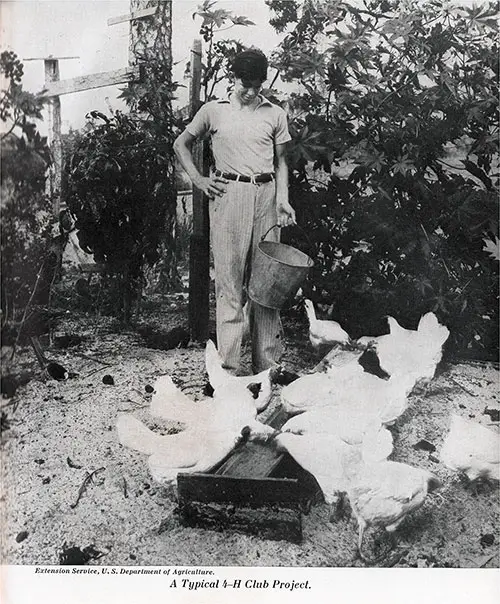
A Typical 4-H Club Project -- A Youth Feeds the Chickens. Photograph by the Extension Service, U.S. Department of Agriculture. Rural Youth -- Their Situation and Prospects, Works Progress Administration, Division of Social Research, 1938. GGA Image ID # 1534ec3bf3
In addition there are many localized projects with varying characteristics scattered throughout the country. Often experimental in nature, they are performing important functions in widening the opportunities and outlook of rural youth.
In spite of excellent work on the part of various agencies, govern- mental and nongovernmental, the problems of rural youth as a whole are still far from being solved.
Although much has been accomplished to ameliorate conditions resulting from the depression, probably the majority of rural youth have not had the advantages of any specialized program.
THE LONG-TIME PROBLEM
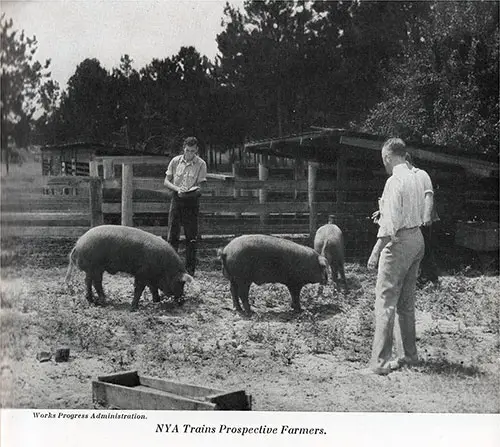
The NYA Trains Prospective Farmers. Photograph by the Works Progress Administration. Rural Youth -- Their Situation and Prospects, Works Progress Administration, Division of Social Research, 1938. GGA Image ID # 1534f7facb
The long-time rural youth problem is that of an excess in numbers in relation to a dearth of rural opportunities, a situation which be- comes greatly aggravated during "hard times." Yet rural youth need not necessarily face constricted opportunities if society assumes its full responsibility for this great human resource.
While equality of educational opportunity is generally accepted as a fundamental democratic principle, the fact must be clearly faced that there is not equality of educational facilities in rural America.
Because of such inequalities, there are thousands of out-of-school rural youth inadequately prepared to cope with the problems of modern life.
In view of the limited financial resources available in many rural areas, it seems clear that the Federal Government must extend greatly increased support if the democratic ideal of equality in education for rural youth is to be realized.
No amount of education will be of much benefit to rural youth, however, if adequate opportunities for gainful employment are lacking. Agriculture cannot begin to absorb the increasing number of rural youths.
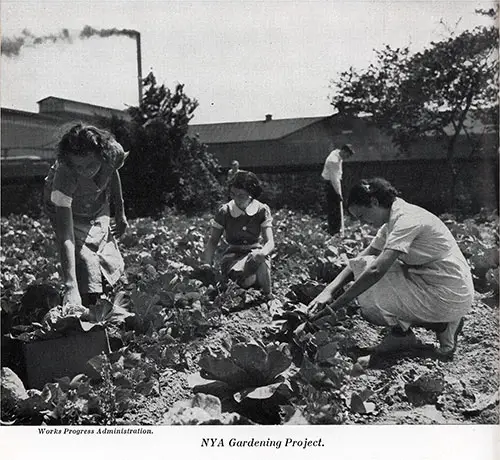
A NYA Gardening Project for Young Female Youths. Photograph by the Works Progress Administration. Rural Youth -- Their Situation and Prospects, Works Progress Administration, Division of Social Research, 1938. GGA Image ID # 15350f0382
Migration to urban centers will not meet the situation unless it is carefully directed. Even with guided migration cities are unlikely to be able to absorb the vast numbers of rural youth who ought, under present conditions, to leave rural territory.
While agricultural developments point toward even further restrictions in opportunities for youth on farms, the expansion of the field of service occupations holds possibilities for large numbers of young people. This development, however, is contingent on rural areas being able to support the social services they so badly need.
The consequences of inequality are nowhere more apparent than in the social and recreational life of young people. Dull and uneventful communities do not necessarily breed antisocial behavior, but they may yield lethargic and restricted personalities.
Society must accept the responsibility of providing not only educational and economic opportunities for rural youth but also adequate recreational and social facilities if well-rounded personalities are to be developed.
Society must recognize the exploitation and waste of its young manhood and womanhood which now exist. A concerted frontal attack has yet to be made on the long-time factors responsible for the widespread destitution and restricted social opportunities of rural youth.
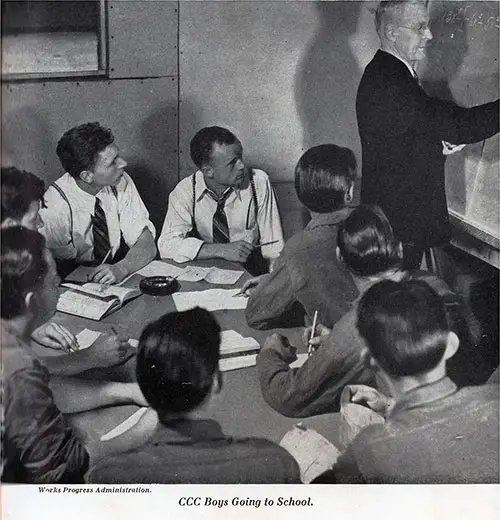
CCC Boys Going to School. Photograph by the Works Progress Administration. Rural Youth -- Their Situation and Prospects, Works Progress Administration, Division of Social Research, 1938. GGA Image ID # 15351ddcf0
Bruce L. Melvin and Elna N. Smith, "Transmittal Letter," "Introduction," and "Summary," in Rural Youth: Their Situation and Prospects, Division of Social Research, Works Progress Administration, Research Monograph XV, Washington, DC: United States Govenment Printing Office, 1938.

